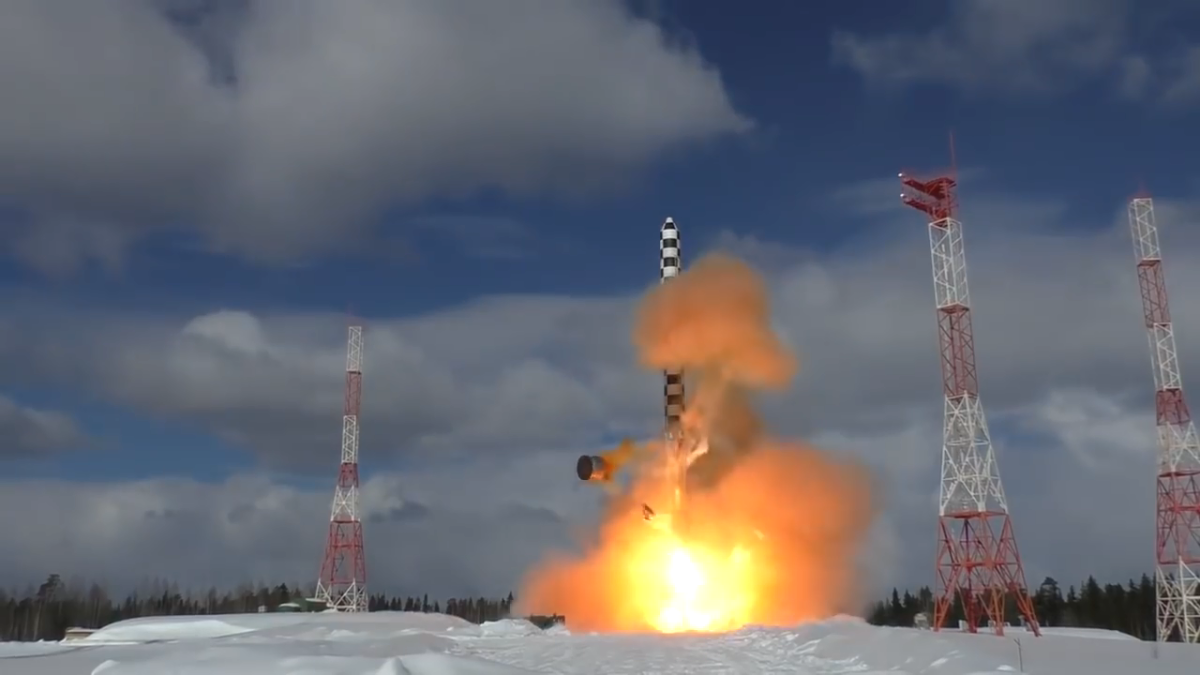
Moscow tested two nuclear-capable weapons just ahead of a speech in which Russian President Vladimir Putin warned of a potential ballistic response to missile threats against his country.
In his annual State of the Nation speech Wednesday, Putin criticized the United States's recent decision to abandon the Intermediate-range Nuclear Forces (INF) treaty and cautioned against anticipated plans to deploy land-based missiles with ranges restricted by the 1987 agreement. The Russian leader has already ordered retaliatory deployments and warned that such weapons would not only target U.S. missile systems, but also "the decision-making centers that are behind the missile systems which threaten us."
The remarks came a year after Putin's last annual address, when he announced the development of several advanced weapons systems he touted as invincible to modern defenses. These included the RS-28 Sarmat superheavy intercontinental ballistic missile and the Poseidon underwater drone, both of which have recently undergone new testing.
"Sea trials of the Poseidon unmanned underwater vehicle have been successfully completed. The personnel of the Poseidon submarine carrier have completed training," Russian Defense Minister Sergei Shoigu told reporters following Putin's address. "We have started the next stage of testing the Sarmat missile system. The strategic nuclear and general-purpose forces are being rearmed as planned. The main goal of this work is to ensure the military security of this country without increasing the current budget expenditures or joining an arms race."

Shoigu also highlighted progress made on hypersonic weapons such as the Avangard glide vehicle and the Kh-47M2 Kinzhal air-launched missile. He said that the "preparation of the missile infrastructure in the Orenburg region for the deployment of the first regiment with the Avangard complex is already in full swing" and would be on "combat alert" by December. Meanwhile, he added, "the MiG-31 crews equipped with the Kinzhal hypersonic missiles, have already performed over 380 sorties on air patrols over the waters of the Black and Caspian seas."
Putin has claimed the Sarmat—nicknamed "Satan 2" by the U.S.-led Western military alliance—"has practically no range restrictions" and "is untroubled by even the most advanced missile defense systems." He has argued that "there is simply nothing in the world capable of withstanding" the Poseidon and boasted his hypersonic weapons could "overcome all existing and prospective anti-aircraft and anti-missile defense systems."
The U.S. has cast doubt on Russian claims, including certain capabilities of these new weapons. Still, Washington has accused Moscow of actually downplaying the range of another new nuclear-capable weapon, the Novator 9M729 cruise missile, which the U.S. has contended was in violation of the INF due to it allegedly being capable of firing missiles between the restricted 310 to 3,420-mile range, a charge Russia has denied.
President Donald Trump first announced his intention to leave the INF treaty in October and ultimately suspended the deal earlier this month, with plans to fully exit in about six months. The move triggered outrage among Russian officials, who have accused the Pentagon of already breaking the INF by installing missile defense systems they contend could be used offensively to target Russia from NATO states.

Last month, Trump also revealed his 2019 Missile Defense Review, an ambitious plan to counter new hypersonic and cruise missile technology being developed by Russia, as well as China, which was not a party to the INF. The Republican leader vowed to "ensure that we can detect and destroy any missile launched against the United States anywhere, anytime."
The project included proposals for new and additional existing anti-missile systems, as well as space-based interceptors, an idea that drew comparisons to former President Ronald Reagan's infamous "Star Wars" program, officially known as the Strategic Defense Initiative, in the 1980s. The initiative failed due to high costs, technological shortcomings and a trend of non-proliferation pursued by the Cold War rivals, which produced such arms control efforts as the INF and the Strategic Arms Reduction Treaty (START).
With the world's two leading military powers again threatening one another and such weapons treaties in jeopardy, however, both sides have accused one another of further stoking tensions and pursuing destabilizing policies that could lead to an all-out arms race. Putin further warned Wednesday that the U.S. "should calculate the range and speed of our prospective weapon systems...and after that make decisions that can create additional serious threats for our country as, of course, this will lead to retaliatory actions from Russia, whose security will be reliably and unconditionally ensured."
Uncommon Knowledge
Newsweek is committed to challenging conventional wisdom and finding connections in the search for common ground.
Newsweek is committed to challenging conventional wisdom and finding connections in the search for common ground.
About the writer
Based in his hometown of Staten Island, New York City, Tom O'Connor is an award-winning Senior Writer of Foreign Policy ... Read more
To read how Newsweek uses AI as a newsroom tool, Click here.








